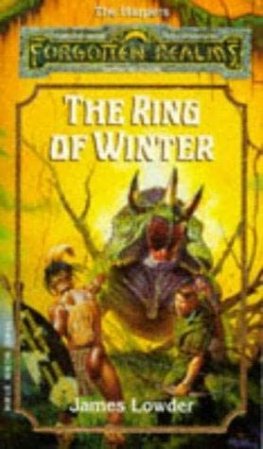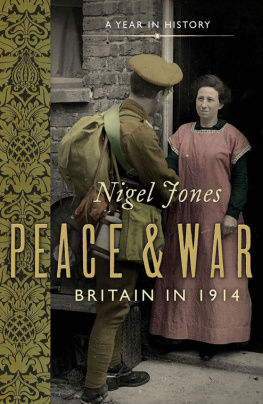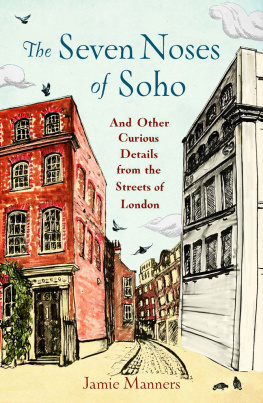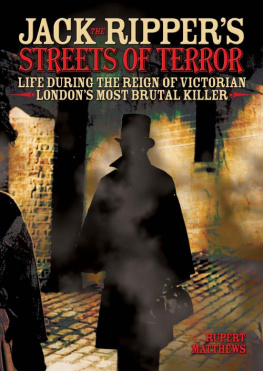LONDON'S TEEMING STREETS 18301914
LONDON'S TEEMING STREETS 18301914
James Winter
First published 1993
by Routledge
2 Park Square, Milton Park, Abingdon, Oxon, OX14 4RN
Transferred to Digital Printing 2005
Simultaneously published in the USA and Canada
by Routledge Inc.
270 Madison Ave, New York NY 10016
1993 James Winter
Phototypeset in 10 on 12 point Palatino by Intype, London
All rights reserved. No part of this book may be reprinted or reproduced or utilized in any form or by any electronic, mechanical, or other means, now known or hereafter invented, including photocopying and recording, or in any information storage or retrieval system, wihtout permission in writing from the publishers.
British Library Cataloguing in Publication Data
A catalogue record for this book is available from the British Library
Library of Congress Cataloging in Publication Data
Winter, James H.
London's teeming streets: 18301914/James Winter.
p. cm.
First published in London in 1993 and simultaneously published in the USA and Canada.
Includes bibliographical references and index.
1. City trafficEnglandLondonHistory. I. Title.
HE363.G75L687 1993
388.40942109034dc20 92-37661
ISBN 0415035902
Front Jacket illustration: engraving by Gustave Dor showing congested traffic by Ludgate Circus. From G. Dor and B. Jerrold, London: A Pilgrimage (1872).
CONTENTS
PLATES
(between pages 80 and 99)
ACKNOWLEDGEMENTS
On the long journey from there to here, many friends and colleagues gave directions when I wandered, especially Judith Allen, Peter Bailey, Tom Blom, George Edgerton, Tina Loo, Richard Mackie, Harvey Mitchell, Fred Stockholder, John Norris, Peter Ward, and Robert Winter. Margerie Sinel warned about rough places and helped grind some of them down. Grants from the SSHRC and from the University of British Columbia supplied much of the fuel; seat ? 6 in the Round Room of the British Library provided a fixed place; Brian Hurwitz gave me shelter and sustenance of every kind. My thanks to them all go far beyond the limits set by the conventions of formal acknowledgements. Even more scope would be required to convey the gratitude I feel toward Pierrette, my wife, constant companion, and well-disposed critic, and toward Ruth Richardson who lighted the way, from conception to completion: no traveller through nineteenth-century London could possibly find a better guide.
Thanks are also due to the following institutions for permission to reproduce illustrations from their collections: The British Library for the photograph of Olive Malvery from The Soul Market; the Bodleian Library, University of Oxford, for the postal card reproduction showing a Shoeblack and the cartoon of the German Band; the Greater London Photographic Library for the photographs of Kings way in 1905, the LCC tramcar and trailer, Fleet Street in 1890, and Traffic on Queen Victoria Street; the Salvation Army, International Heritage Centre, for the photograph of the Army march on Whitechapel Road and the cartoon of Happy Eliza Haynes. In addition, I wish to thank The London Journal for permission to reproduce passages from my article, The Agitator of the Metropolis, which appeared in vol. 14 (1989), 2942.
INTRODUCTION
Since the time when, as a teenaged soldier, I negotiated my way through blackout and brown fog, the streets of London have been among my preoccupations; but always my view has been that of an outsider and not, in any true sense, of a direct participant. My home lies half a world away. The street where I live was once on the harbor-front fringe of a small town that grew up around a lumber mill late in the nineteenth century. Now my street stands on the edge of one of those central city restoration projects that one finds in almost every North American city. Gold Rush era buildings have been stripped back to their handsome brickwork and the huge timber beams inside have been exposed; the main street has been paved with brick and stone; ornamental cast-iron lamp-posts are back again; in the summer months, two young ladies in flowery hats and long, old-fashioned dresses give directions to tourists who disembark from cruise ships to look in the shops that sell the things tourists seem willing to buy. So far, my part of the street has not been absorbed into that effusion of commercialized nostalgia but serves as the border area between fantasy and hard and not always sober reality. A block away is a shelter for the homeless; outside my door is an agency for assisting street people who have mental illnesses. The building which I share with other middle-class condominium owners was once a shelter for girls who had drifted into the city and found themselves alone and unprotected. A curiously shaped Anglican church not far away once ran the shelter and still continues to tend the sick, hungry, and dazed casualties of urban life. Just south of the church is one of the largest Chinese communities on the continent, and there the streets are jammed with shoppers making their way around stalls full of bak tsoi, gai tsoi, gow tsoi, bitter melons, hairy melons, winter melons, baskets of dried shrimp, squid, abalone, tanks of live fish and crabs, enormous frogs in wicker cages, beautiful pots filled with black-crusted duck eggs. The drama of that theatre makes the principal shopping streets and underground shopping malls a fifteen-minute-walk to the west seem, if possible, more banal and antiseptic than they already are.
In my city, traffic and transit become ever more pressing issues as two-income families discover they must go farther away from the centre where they work to escape the mounting ground rents. Bulldozers are constantly at work carving housing plots out of market gardens and out of the forests that used to give the city its reason for being. Not far away, but invisible behind another building on my street, the harbor narrows and a bridge connects a separate municipality on the North Shore with the major artery bringing vehicles into the city from the east. To unplug the stoppage that tends to occur there at rush hour, a new tunnel delivers the driver to the bridge and offers a sudden, stunning view of ocean and snow-capped peaks; nevertheless, concerned citizens are now asking how the bridge is to hold the heavier flow of traffic and how the receiving community, already chewing its way up the mountain side, will be affected. Not surprisingly there is a call for more planning and more co-operation between the various local authorities, as the once well-defined city transforms itself into a metropolitan region.
The setting is breathtaking, the climate is gentle, the pace of life is relaxed; otherwise this city is much like any other, the problems of growth and decay, movement and congestion, delight and fear not much different in quality from what other Western European and North American cities have been experiencing for a longer time than most modern urban dwellers are aware. Like most urbanits, we treat our problems and choices one by one. They become events which, when they are given any extension in time at all, are thought of as peculiar to the latter part of the twentieth century. We cannot think clearly about events which are presented to us episodically because we cannot see them clearly. Ferdinand Braudel writes:
Take the word event: for myself I would limit it, and imprison it within the short time span: an event is explosive, a








